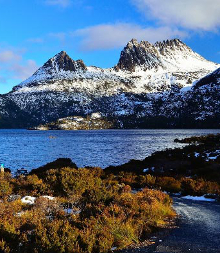Native decline in overdue report
 Tasmania has released its first State of the Environment report in 15 years.
Tasmania has released its first State of the Environment report in 15 years.
The report warns of escalating environmental challenges driven by climate change and other human impacts.
The 666-page document, tabled in Parliament this week, highlights significant environmental deterioration across the state, calling for urgent action to protect its unique ecosystems.
The report assessed 29 environmental categories, showing that more than half are in decline.
Key areas such as sea temperatures, kelp forests, and migratory shorebird populations are worsening.
According to the report, average sea surface temperatures have increased by 2.5 to 3.8 degrees Celsius since 1944, significantly impacting marine life, particularly Tasmania's once-thriving kelp forests.
The document also reveals a sharp decline in native species.
Seventy-six out of 460 vertebrate species are currently threatened, while 41 plant species have been added to the endangered or threatened list since 2002.
The report notes that native vegetation has decreased by nearly 4 per cent since 2009, primarily due to illegal clearing.
The report makes 16 recommendations, emphasising the need for long-term strategies to address these environmental challenges.
The first of these recommendations calls for a comprehensive vision and strategy to safeguard Tasmania's environment, with updates to Parliament every two years.
Other recommendations include strengthening marine protected areas to help ecosystems cope with rising sea levels and warming oceans.
It also urges greater collaboration with the Aboriginal community to integrate Indigenous knowledge into environmental management, as well as a review of Tasmania’s coastal policy, to account for the impacts of climate change and human activities.
“Tasmania is experiencing significant impacts from climate change,” the report says.
These impacts include rising sea levels and the loss of kelp forests, alongside an increasing threat of bushfires, which have already caused extensive damage to iconic vegetation communities.
“It will require determination, commitment, creativity, innovation, coordinated effort, strong and careful leadership and significant investment to ensure that our environment remains an ongoing source of pride for all Tasmanians,” it stated.
The release of the report follows years of non-compliance with legislative requirements, which mandate that a State of the Environment report be published every five years. The last report was produced in 2009.
Environmental advocates have criticised the delay, with the Australia Institute calling the report a “scathing indictment of the Tasmanian Government’s environmental mismanagement”.
“Too often they are putting foreign profits ahead of Tasmanians’ wellbeing, because we all rely on a healthy environment,” said Eloise Carr, director of the institute’s Tasmanian branch.
Carr also highlighted the lack of funding for the Tasmanian Planning Commission, which saw its budget cut by $400,000 despite the urgent need for action.
“It is clear from last week’s budget that all the Government intends to do about the report is read it,” she said, accusing the government of failing to commit to implementing its recommendations.
The report's findings underscore the deficiencies in Tasmania's environmental monitoring programs, making it difficult for authorities to make informed decisions.
As a result, critical areas such as water quality and wetlands remain poorly understood, and action plans are hindered by insufficient data.
Tasmania’s State of the Environment Report 2024 is accessible here.








 Print
Print